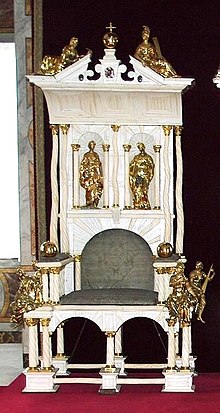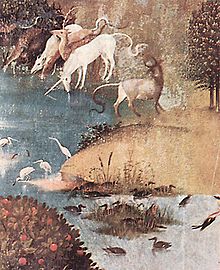
The unicorn is a legendary creature that has been described since antiquity as a beast with a single large, pointed, spiraling horn projecting from its forehead.

The narwhal, is a species of toothed whale. It is a member of the family Monodontidae, and the only species in the genus Monodon. An adult narwhal is typically 3.0 to 5.5 m in length and 800 to 1,600 kg in weight. The most prominent feature of the species is an adult male's long single tusk that can be up to 3 m (9.8 ft). The narwhal has a mottled pigmentation, with blackish-brown markings over a white background. Instead of a dorsal fin, it possesses a shallow dorsal ridge. It is a social animal, and may associate in groups of up to 20 members. Carl Linnaeus scientifically described the species in 1758 in his work Systema Naturae.

Saverne is a commune in the Bas-Rhin department in Grand Est in north-eastern France. It is situated on the Rhine-Marne canal at the foot of a pass over the Vosges Mountains, and 45 km (27 mi) northwest of Strasbourg.
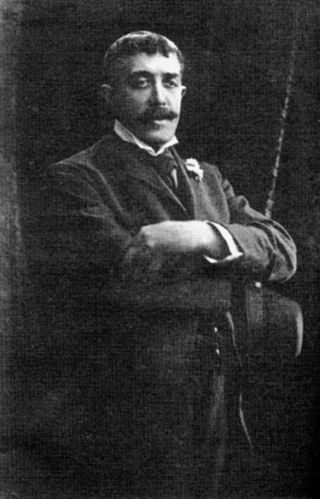
Jean Lorrain, born Paul Alexandre Martin Duval, was a French poet and novelist of the Symbolist school.

The Lady and the Unicorn is the modern title given to a series of six tapestries created in the style of mille-fleurs and woven in Flanders from wool and silk, from designs ("cartoons") drawn in Paris around 1500. The set is on display in the Musée de Cluny in Paris.

The Musée de Cluny, officially Musée de Cluny-Musée National du Moyen Âge, is a museum of medieval art in Paris. It is located in the 5th arrondissement of Paris, bordered by square Samuel-Paty to the south, boulevard Saint-Michel to the west, boulevard Saint-Germain to the north, and rue Saint-Jacques to the east.

The Jardin des plantes, also known as the Jardin des plantes de Paris when distinguished from other jardins des plantes in other cities, is the main botanical garden in France. The term Jardin des plantes is the official name in the present day, but it is in fact an elliptical form of Jardin royal des plantes médicinales, which is related to the original purpose of the garden back in the 17th century.

The French National Museum of Natural History, known in French as the Muséum national d'histoire naturelle, is the national natural history museum of France and a grand établissement of higher education part of Sorbonne Universities. The main museum, with four galleries, is located in Paris, France, within the Jardin des Plantes on the left bank of the River Seine. It was formally founded in 1793, during the French Revolution, but was begun even earlier in 1635 as the royal garden of medicinal plants. The museum now has 14 sites throughout France.

Ambroise Paré was a French barber surgeon who served in that role for kings Henry II, Francis II, Charles IX and Henry III. He is considered one of the fathers of surgery and modern forensic pathology and a pioneer in surgical techniques and battlefield medicine, especially in the treatment of wounds. He was also an anatomist, invented several surgical instruments, and was a member of the Parisian barber surgeon guild.
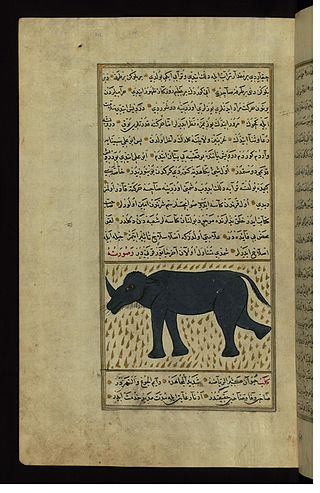
The Karkadann is a mythical creature said to have lived on the grassy plains of India and Persia.

Auguste Ambroise Tardieu was a French medical doctor and the pre-eminent forensic medical scientist of the mid-19th century.

The Musée de la Chasse et de la Nature is a private museum of hunting and nature located in the 3rd arrondissement of Paris, France. The museum is served by the Rambuteau Paris Métro station.

A bezoar is a mass often found trapped in the gastrointestinal system, though it can occur in other locations. A pseudobezoar is an indigestible object introduced intentionally into the digestive system.
Khutu was the name given to a material used by medieval Islamic cutlers for knife handles. The ultimate source of the material has been a matter of conjecture for more than a thousand years; Islamic polymath al-Biruni was among the first to investigate it and debate about the material—especially its source—continues to this day. The hypothesized sources for the material have included narwhal, walrus, and mammoth ivory, the frontal bones of bulls, goats, and birds, the teeth of snakes, fish, and hippopotamuses, and the root of a tree. The most recent investigation, by natural historian Chris Lavers, has pointed to the frontal boss of the horns of the muskox.
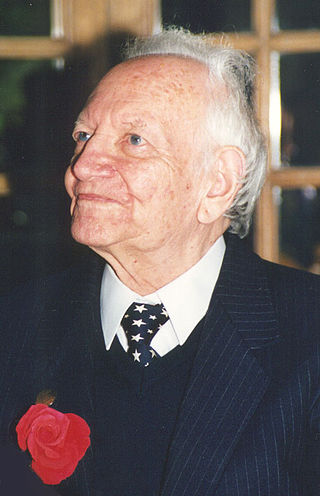
François Brousse was a philosophy professor who had mainly taught in the Languedoc-Roussillon region and is the author of some 80 works including poetry, essays, novels, plays and storybooks. He was a pioneer of the philosophy cafes that were popping up almost everywhere in France at the end of the 20th century. Brousse was born in Perpignan, France and died in Clamart, France.
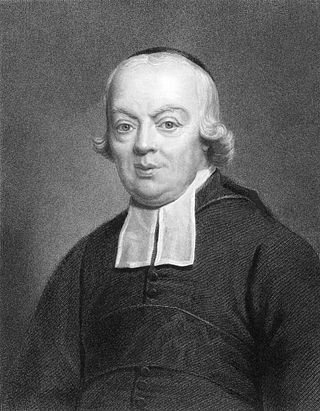
Charles-Michel de l'Épée was a philanthropic educator of 18th-century France who has become known as the "Father of the Deaf".
The year 1582 in science and technology included a number of events, some of which are listed here. This year sees the introduction of the Gregorian calendar, promulgated by Pope Gregory XIII in the Papal bull Inter gravissimas on February 24 and based largely on the work of Christopher Clavius. Under the Habsburg monarchy in Spain, Portugal and Italy, together with the Polish–Lithuanian Commonwealth, the year continues under the Julian calendar as normal until Thursday October 4, the next day becoming Friday October 15; France follows two months later, letting Sunday December 9 be followed by Monday December 20. Other countries switch in later years.
Jean Canappe was a French physician who was attached to Francis I of France in 1542. He sometimes wrote under the pseudonym Philiatros and was known because he contributed to the transmission of medical and surgical knowledge in French with Pierre Tolet.
Dominique Bourgoing was a French physician in the household of Mary, Queen of Scots. He is notable as the author of an influential account of Mary's captivity and execution.
